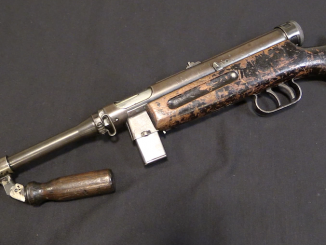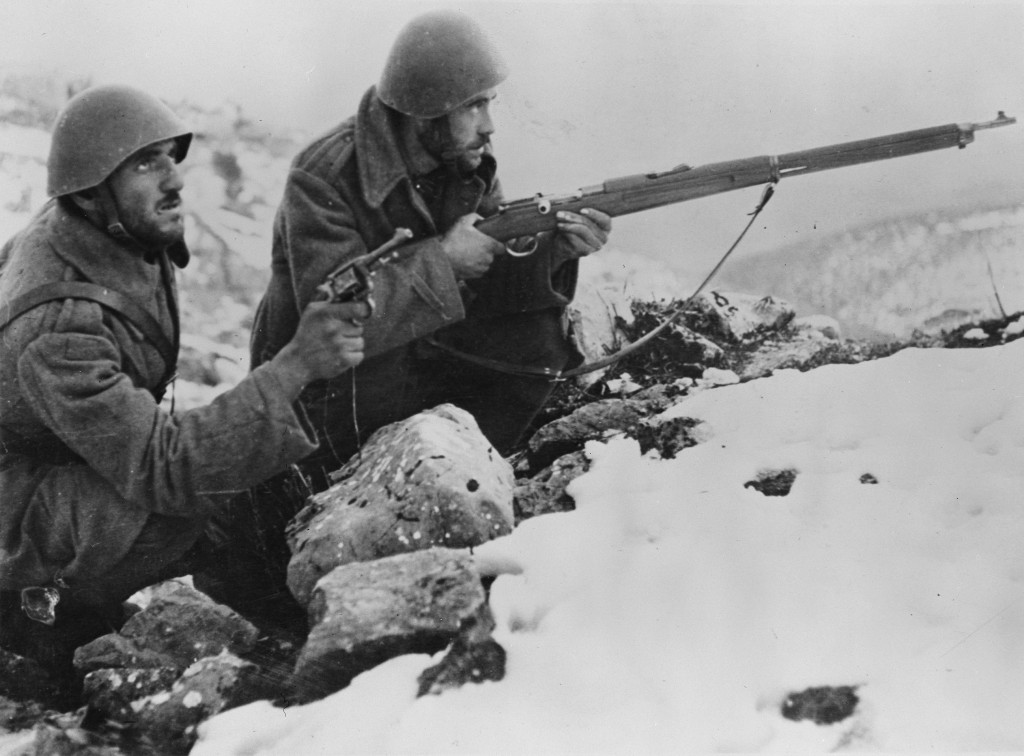Greek soldiers in the winter of 1940/41, fighting Italy. Note the 1903 Mannlicher-Schönauer rifle, one of very few military rifles to use a rotary magazine.
Related Articles

Light MGs
Vintage Saturday: Too Sexy For My Shirt
Greek soldiers practicing antiaircraft fire with a model 1926 Hotchkiss LMG – note the AA extension on the tripod. Thank to Di for the photo!

Light MGs
Hotchkiss M1922 LMG
Many people are unaware of just how many different firearms were produced by the Hotchkiss company over the decades – not many of them received the worldwide acclaim of the more well known arms companies. […]

Gunsmithing
EOKA Cut-Down Beretta 38 SMG
This cut-down Beretta Model 38/44 submachine gun was made by the EOKA (Ethniki Organosis Kyprion Agoniston) terrorist group, which fought in the late 1950s for Cyprus to be reunified with Greece, instead of being a […]


Do you have info on the revolver?
I believe they still issued the Bodeo Model 1889 but that one doesn’t look quite like it to me. Maybe I’m nuts (no comments please) bit it reminds me of a Nagant…
OK, as far as the Bodeo is concerned, they didn’t issue them. If, repeat if,, it is one them it’s a capture. I’m fairly certain now that that is a Nagant…
Spain Nagant New Model American 1912 Manufactura Espesial De Revolvers Garate Anitua Y Cia Eibar Espana or Francisco Arizmendi cal. 7,62 mm Nagant Long vel .300 Nagant Long, .300 Turkish carbine, 7,62 mm (.300) Nagant Long, 7,62 mm Nagant, 7,62 mm Nagant revolver, 7,62 mm Nagant Russe, 7,62 mm Russian revolver, Cal. .300 (7 m/m 62) Nagant Long
Is that a Nagant pistol?
Definitely a Nagant 1895 revolver with a post-1932 front sight on it.
https://www.kalashnikov.ru/falshivyj-amerikanets-ispanskij-revolver-nagan-magnum/
Bingo! Περίστροφον M1895 – no gas seal…man, talk about an anemic round…
Similar to .32 S&W Long standard loadings, so by the standards of the 1890s it was not unusually anemic.
Περίστροφον L.Nagant 1898 with gas seal,double action,made in Belgium(Liege)…The main hand gun of Greek officers from 1907 till 1922… About 500 revolvers where still in use till 1940-41..
That’s very interesting. Can you tell me what pistols the Greek army used, from 1922 until 1980s?
“Other Nagant revolver designs were also adopted by police and military services of Sweden (7.5mm M1887), Norway (M1893), Poland, and Greece (Περίστροφον M1895). These revolvers were largely similar to the Russian Nagant M1895, but lacked the gas seal mechanism.”
From Fremdgerät I can say that Greece use at least 2 models of Nagant – Nagant 95 called by Germans “Revolver 612(g)” and Nagant 12 called “Revolver 613(g)”
The German designations for Greek revolvers issued to the Wehrmacht were
Revolver 612 (g) Greek Nagant 1895 7.62mm
Revolver 613 (g) Greek Nagant 1912 7.62mm
Revolver 648 (g) Greek contract Colt Official Police .38 Spl.
Revolver 649 (g) Greek contract S&W M&P .38 Spl.
I found the last two rather surprising, as I was unaware that the Greek army or police used any American-made small arms prior to MAP. Of course, they did buy two pre-dreadnought battleships from us, so maybe it isn’t all that surprising.
What does get me wondering is the caliber of the Nagants. I would have expected them to be in 9x22R, rather than 7.62x39R, since the majority of the Greek Nagants came from Peiper in Belgium. Of course, the 9mm revolver round dated to 1878 and was considered pretty thoroughly obsolete before WW1.
cheers
eon
Revolver 648 (g) Greek contract Colt Official Police .38 Spl., Revolver 649 (g) Greek contract S&W M&P .38 Spl.,they are Spanish copies of Colt and S&W rather than expensive American weapons
I don’t know about Greek Nagants, but Polish ones were gas-sealed, and the model date of the Greek one seems to indicate that it is also a sliding-cylinder one. The Nagant 1912 was not a gas-seal wheelgun – it was a thoroughly redesigned revolver with a yoke-mounted swing-out cylinder. But this one looks 95-ish to me.
Sorry for the confusion people…too much coffee…
The Greeks used the Pieper made Nagant revolver model 1886. Piper, had the patent. Nagant brothers only got permision to use it in 1889, when Pieper started the FN factory. Pieperrestarted his own factory in 1896, when Loewe brothers brought the FN.
Pieper started in 1907 to produce the Bergmann-Bayard pistols, witch the greeks brought some of. Pieper´s factory funktionen until 1953 when FN took over the buildings and produktion facilities at rue de Bayard 12
It is defenetly a russian Nagant so the picture must be post 1932
The fellows in the photograph look drawn, hungry and exhausted, a reflection of the exigencies of that campaign.
Rotary mag, as in the Johnson?
So far I know the Mannlicher-Schönauer is considered as a fine hunting rifle, but
also in hunting rifles that type of magazine is rare – I can point Savage Model 99 for example. The big advantage of rotary magazine is that it can work properly even if the cartridge has strange shape – check the available chamberings for Savage Model 99.
Fact that you’re can offer firearm in standard army caliber is a big advantage – for this reason the Maxim machine gun was highly successful.
Teekay
I have noted a delicious irony in this photo. The Schonaurer uses a rotary magazine fed by (I presume) stripper clips like the Johnson semi- automatic rifle. The opposing Italian army used the Carcano: the only other rifle in mass use using a monobloc clip like the Garand. Any more info on which was best in action?
For the very best article I have ever read on the Johnson (and it is a riveting read in any case), see a blog by BarryinIn at http://www.practicalshooting.co
Teekay
There were many other bolt action rifles which utilized an en bloc clip besides the M91 Carcano: the German M1888 Commission rifle and the Austrian M95 Mannlicher were probably the most significant ones, but there were others like the M1870/87 Vetterli-Vitali, the predecessor of the Carcano.
The link isn’t working and the domain appears to be up for sale
There was a drawback to the rotary magazine of the Mannlicher-Schönauer rifle. The temperatures that existed in the Greek-Albanian border ranging from -0,40 F to 14 F, causing the froze of the maintenance oil of the magazine causing difficulty in feeding the gun. The orders asked by the soldiers to thoroughly remove the oil from the magazine.
A common problem in winter conditions during WW2, especially at temperatures below -10 degrees Celsius (14 F). I don’t know how much the rotary magazine might have contributed to the problem. During the Winter War Mosin-Nagants were used “dry” for the same reason, and the action had nothing to do with it. It was just that the oils of the day would not stay fluid at temperatures below -20 degrees Celsius.
When my grandfather went to the Belgium Congo in the 1920’s as a Methodist missionary, along with his Bible and carpenter’s tools, he took a Webley and a Mannlicher-Schönauer. As a WW I vet, he said he had been very impressed with the rifle and wanted something accurate and reliable. It served him for 30 years until the nationalist violence of the 1950’s caused a speedy evacuation. He was not allowed to take his weapons, which by that time included other long guns, so he buried them in the hopes or returning soon. That was not the case, and a friend who did unearth them later found them ruined.
I have always wanted to see one and hope to be able to fire one some day.
When the Wehrmacht retreated from Greece in 1944 many soldiers swapped their K98 against a Carcano with their Greek “collaborators” and left stockpiles of ammo and heavy gear behind against a communist invasion or takeover. The subsequent civil war proved them right.
Another irony is that many of the Greek M-S rifles were made in Italy by Breda in 1927. I believe that Greece was the only country to use the 6.5X54mm M-S round in a military weapon. (However, the Netherlands and Romania use a rimmed version of virtually the same cartridge in their Mannichers). Of course the Italian Carcano is also a Mannlicher design and the 6.5X53mm Carcano round is ballistically almost identical to the M-S round.
I once owned a Breda manufactured Greek M-S service rifle. Even with a rough bore, it was a real ‘tack driver’ with 139 grain bullets. However, it could no longer stablize 160gr. service rounds. The workmanship on my Breda manufactured (Mannlicher-Schoenauer) Greek service rifle was very good.
I remember several years back seeing a Greek M-S sell for about $250. I still regret not buying it.
Another Saturday blog that has lead to a bit of study. A lot to study about WW2 and I’ve never study this part of it. I found a documentary on this war to watch. I think it’s in Greek(don’t think I’ve ever heard one word of Greek) and has English sub titles.
http://www.youtube.com/watch?v=EFwR9-KOFp8
The 6.5mm’s in this power range are about my favorite round for a rifle. Not to weak, not to powerful and pleasant to shoot.
Well done for publishing this interesting photo. We should remember that Mussolini invaded Greece in October 1940 as part of his deluded idea to re-establish the Roman Empire. The Greeks not only stood up to his much bigger army, but actually forced it back into occupied Albania. Eventually Hitler had to send German forces into Greece to save his ally in April 1941. Though Greece was defeated, the battle for Greece helped to delay Operation Barbarossa, which meant the Germans never reached Moscow before the onset of the Russian winter. We have a lot to thank the Greek soldiers with their interesting rifles.
This is new historical concept in my perception of WWII operations and German plans in particular. I always thought that end of operations over British Isles in spring of 1941 served as period of preparations for staging Barbarossa. Of cause, the seizure of British operation was for this particular purpose and not a defeat as widely sold to public. But that is different subject.
Many historians think the operations in Greece put back Barbarossa by 4 to 6 weeks. Both Hitler and Churchill agreed on that, if nothing else!
Regarding rifle in photo: The M-S rifle seems to be missing the ‘stacking rod’ from its front barrel band, as well as, its cleaning rod. (Probably practical field modifications).
The ergonomics of the Greek M-S were quite good, IMHO.
A friend recently picked up a 1930 FN Mauser with the Greek Crest on the receiver ring in 8X57mm Mauser. Greece, like Italy, was dealing with the logistical nightmare of two Infantry rifle calibers.
As for Italy, not very much in practice. The 7.35x51m Carcano rifles were not widely issued to combat troops. 100,000 were sold to Finland in 1940 and production switched back to 6.5mm Carcanos. The remaining 7.35mm rifles were only used as training and reserve weapons.
Finland, on the other hand had three different major rifle calibers in use from 1940 to 1945; the well-known 7.62x54R for Moisin-Nagants, 7.35x51mm for the aforementioned Carcanos (called Terni rifles in Finland according to the manufacturer) and 6.5x55mm Swedish Mauser. In addition to that heavy (MG-08) and light machine (FN D) guns in 8x57mm were also used in significant numbers…
I never understood why Greece did that. Surely FN would’ve been willing to make Mausers in a 6.5x54mm chambering.
The photo was taken by an American journalist of a San Francisco newspaper … It was the first photo with which the Americans were informed about the Greek-Italian war 1940-41 …Περίστροφον L. Nagant 1898 and Ελληνικόν τυφέκιον Υ1903/14 Mannlicher–Schönauer with the famous rotary magazine…